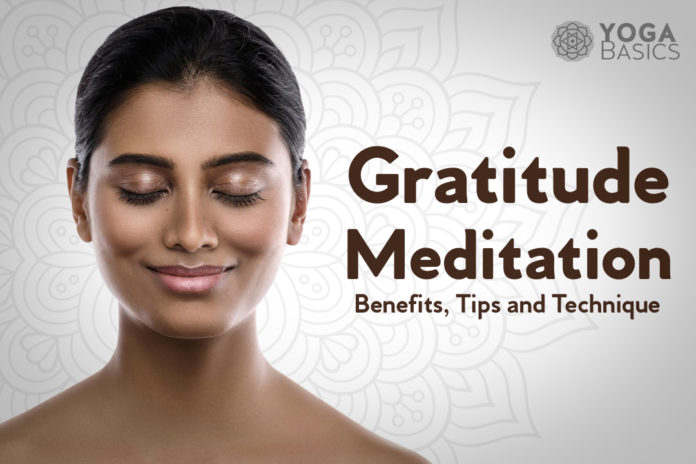Meditation has been practiced for thousands of years for enlightenment, mindfulness and inner peace, yet it only recently has been incorporated with the practice of gratitude. Gratitude mediation encourages you to focus on the things you are grateful for in your life. It helps you appreciate the small blessings in your life and boosts your mental and physical health. Gratitude meditation is a great way to start each day and end each day with happiness and joy. It’s also a powerful way to reap both the benefits of meditation and a practice of gratitude.
What is gratitude meditation?
In gratitude meditation, you focus your attention on feeling grateful and appreciative. Centering our mind on positive emotions while breathing slowly and deeply promotes a peaceful heart, a clear mind, and a balanced body. As you bring all of your mental focus and concentration to feeling a state of thankfulness and gratitude, your thoughts will quiet down so you can shift into a state of meditation. You can also use this technique any time of day to help overcome any negative feelings or emotions that may be present in your life.
Benefits of gratitude meditation
There are several powerful effects of gratitude meditation that are beneficial for your well-being and mental health. First, it helps you appreciate all that you already have. Second, it helps you develop a sense of gratitude for all that you experience on your life’s journey—both the happy times and challenging moments. Third, it cultivates contentment through appreciation, which leads to more inner peace, happiness, and joy. Finally, meditation for gratitude teaches you to live in the present moment instead of dwelling on the past or worrying about the future.
By focusing our attention on gratitude, other positive habits naturally arise. Practicing gratitude meditation cultivates patience, empathy, generosity, humility, joyfulness, and optimism. It also reduces stress, worry, anxiety, and other negative feelings. Gratitude meditation helps us cultivate an attitude of gratitude towards everything around us, while requiring only a minimal amount of cost, time, and effort.
Gratitude meditation practice technique
- Identify the things in your life that you are grateful for. Write down three things (people, places, experiences, etc.) that you are thankful for right now. For example, I am grateful for my family, my job, and my home.
- Find a quiet place where you won’t be disturbed. Make sure you feel warm, because the temperature of the room will affect your comfort level. If you’re feeling cold, put on a sweater or wrap a meditation shawl around you.
- Find a comfortable position with your back straight. Feel your spine long and your shoulders and jaw relaxed. You can place pillows and blankets under your knees and hips for support.
- Close your eyes and take a few deep breaths into your belly.
- Focus your attention on the first thing on your list. Summon up feelings of gratitude, thankfulness and appreciation for this person, place or experience. Think about how much they mean to you and how lucky you are to have them in your life. Notice how you feel when you acknowledge these things. If your mind wanders, bring your attention back to feeling grateful. Keep breathing slowly and deeply.
- Repeat with the second and third things on your list.
- End your meditation by imagining or feeling blessings of gratitude surrounding you or raining down upon you. Focus on the fact that you have everything you need right now and that and abundance of beauty, peace, and joy surrounds you. Place your hands over your heart and take a few slow deep breaths, feeling gratitude for all the good things that you have in your life.
Tips to deepen your gratitude meditation
- You may wish to keep a gratitude journal so you can record your thoughts and feelings as you go through each session.
- If you are struggling with the above instructions, you can use a guided gratitude meditation video.
- If you need a shorter meditation session, only place 1-2 things on your list. Likewise, for a longer session, create a longer list.
- You can incorporate Sanskrit mantras into your meditation. See our list of the best gratitude mantras to explore.
- Have a regular and consistent practice. For the best results, make it a habit and part of your daily morning or evening routine.
- Consider reading an inspiring quote on yoga and gratitude at the start of your meditation.
- Meditation teacher Jack Kornfield suggests that when you are comfortable with your gratitude practice, you can challenge yourself by being grateful for “neutral people, difficult people, and even enemies—until you extend sympathetic joy to all beings everywhere, young and old, near and far.”
Why should you practice gratitude meditation?
It is said that if you look at your life through rose-colored glasses, you will see only the good things. But if you look at it through dark lenses, you will see all the problems, failures, disappointments, and pain. Gratitude meditation gives us the opportunity to see the lighter side of life. Instead of dwelling on our negative emotions, we can learn to recognize and appreciate the positive aspects of our experiences.
When we experience events and situations as opportunities to grow spiritually and emotionally, then we feel grateful for those opportunities. This leads to a feeling of contentment and happiness. On the other hand, if we see things negatively, we tend to feel stressed out, anxious, angry, upset, and depressed. When we are able to recognize experiences as blessings, then we become happy and thankful. We are grateful for the opportunity to learn and grow.


























